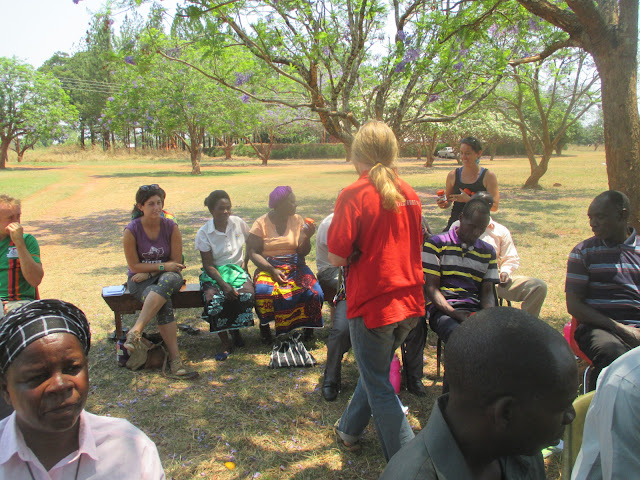Passing by the Kabompo River on our way from Zambezi. The Kabompo River is one of the deepest rivers in Africa. There are many animals that live in and along side it, including crocks and hippos and I'm sure plenty of monkeys. I plan to visit this river in a couple of months and explore. It is a two hour bus ride from where I live.
More pics of the Likumbi Lya Mize ceremony in Zambezi along the river. This is a traditional three day ceremony put on by the Luvale tribe.
We took dugout canoes to cross the river--one kwatcha to cross. About 10 people could fit on the canoes. Some canoes were much longer.
The Zambezi is a shallow river as compared to the Kabompo. The Zambezi ends up at Victoria Falls hundreds of miles south.
A spectator at the ceremony getting a good view.
A Makishi dancer. They perform as clowns at coming of age ceremonies for boys and girls. The costumes represent different characters. The Makishi would run after people and hit them with their sticks (not hard).
My friends I went with and I were maybe a handful of white people at the ceremony. We were constantly asked to have our pictures taken with people with cameras. They don't see white people often; if at all.
Back in my village
My friend Harrison is making my new hoe handle. I broke mine. It's easy to do if they aren't made right.

Fellow Peace Corps Vollunteer, Oliver, is waiting to catch a papaya. This is how they get them down. He did catch it.
Relaxing at nearby Mutanda Falls enjoying a braii (barbecue).
Catnap
And now for my workshop!
I held it in October. It was a big success. The name of it is Northwestern Province Agroforestry Workshop. About 40 people attended from villages across Northwestern Province to learn about all the important uses of trees from food security to soil improvement.
The workshop was held for three days and the first day included a trip to an agriculture research station where we learned about grafting and trees that nitrogen fix soil.
The second day we had a visit from the Solwezi District Forestry Office and learned how to plant trees, build nurseries, and how to make money from trees such as beekeeping and honey production. Chief Mumena visited this day.
The third day I and others from my village facilitated sessions on fruit drying, how to organize groups in tree planting activities and had a tour of the village.
The amazing cooks who kept everyone well fed. All of the cooking was done over charcoal. The electricity was out most of the time so we relied on our torches (flashlights) to see during supper. The borehole had broken a few times. We had to search for alternative water sources. We depended on 20 20liter containers full of water two times per day for drinking, washing dishes, cooking, and bathing.
First day of the workshop at the Mutanda Research Station. Mr. Bwembya (in the white shirt behind the table) is an expert in using trees to improve soil. The man in the striped shirt is Moses, the interpreter.
Chief Mumena visited the second day of the workshop. He gave an amazing inspirational speech about the importance of trees. Chief Mumena forbids charcoal making in his chiefdom which is one of the best things a chief can do to save the forests.
Every morning we had a special treat. These are special-made fritters. They tasted like donuts! Another morning we had homemade rusks, and another morning buns and jam.
Demonstrating seed planting using used shake-shake containers. Shake-shake is a traditional home brew sold commercially. Plenty of them can be found by the roadside.
Great pic of Patricia. She is well-known in the village for her baking. I hired only the best to feed us.
Split everyone into groups for this session on developing tree-planting activities. Each group presented their plan.
Happy with how things are running. Peace Corps Volunteers selected representatives from their villages to attend the workshop They were to be enthusiastic learners of trees and encouraged to continue on with tree planting in their villages and teaching others.

Volunteers helped out. Aubrey (the cute redhead) lead icebreakers which got the participants up and moving about...and laughing.
Ryder passing out dried pineapple and bananas that the Volunteers prepared prior to the workshop.
To my left is Chiefita. He is a friend of mine who runs the Mutanda Center. He also oversees a honey production business. He gave a talk on the honey business which we are trying to promote to lure people away from charcoal making. To my immediate right is Moses. He is my interpreter and my main counterpart. He speaks English fluently and can speak 13 other languages. On my far right is Harrison. He is the village carpenter, indigenous tree expert, and environmentalist. Harrison helped facilitate sessions and interpreted when Moses got tired. My workshop wouldn't have been a success if it weren't for the contributions from these wonderful people.
























Wow Gin! That's awesome and touching. You're doing so much for those people. It will spread throughout that country I'm sure.
ReplyDeleteThanks Bill. Community representatives who participated are still planting trees in their villages. I think the best thing for people to get out of the workshop is the importance of trees.
ReplyDelete